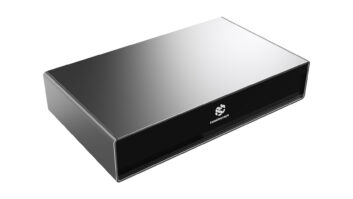Audio/video suppliers are turning to a greater selection of one-piece multichannel surround-bar systems, including the industry’s first Blu-ray-equipped surround-bar systems, to boost the attachment rate of audio systems to flat-panel TV purchases.
The Blu-ray surround bars are from Samsung and JVC, the former with embedded BD player and the latter with separate player.
Dealers looking for new home theater system options at International CES will also find:
- a growing selection of traditional multispeaker home theater in a box (HTiB) systems with integrated Blu-ray players. Panasonic and Samsung are launching new models, and LG and P&F (Funai’s Philips-brand marketing group) are launching their first.
- the first Blu-ray-equipped HTiBs and surround bars with the ability to stream on-demand movies and TV shows from the NetFlix Internet-video service. They’re from LG and Samsung.
- Panasonic’s first Blu-ray HTiBs with Viera Cast Internet service, which accesses content from select Web sites.
- More HTiBs and surround bars with wireless subwoofers to eliminate unsightly wire runs. Suppliers include Philips, JVC and Samsung.
- one of the first home-theater systems with Dolby Volume technology. The system, which is wireless, is from Airfonix.
In other developments, Vizio, Polk and others are expanding their active surround-bar selection here at the show and Sharp will show its first. Dynavox, Kinyo and Memorex are launching new active two-channel sound bars designed to enhance TV sound.
The introductions are part of an ongoing effort by suppliers and major retailers to boost audio’s rate of attachment to TV purchases. Major retailers’ component-audio and HTiB attachment rates range from 5 to 15 percent at the time of a TV sale, and most report attachment rates of less than 10 percent at the time of the TV sale, said Polk Audio founder Matthew Polk. Sound-system purchases after the purchase of a TV, however, boost the attachment rate to about 25 percent, Polk said, citing CEA factory-level sales statistics. “A little over 20 million TVs were sold over the 12 months ending September 2008 vs. about 5.5 million surround-sound receivers and surround systems (HTiBs),” he said.
“At least 75 percent of TV buyers never get any kind of sound other than the speakers built into the TV. That would seem like a huge opportunity for someone. Those buyers clearly don’t want a component system, but what is it that they do want?” HTiBs “have done well relative to components but as a percentage have only just picked up the slack resulting from the decline in components,” he said in citing CEA statistics dating back to 2000. “The real question is why [HTiBs] haven’t been more successful. To me, the reason is that even though an HTiB comes in one box, it still has all the [dissatisfaction] of a component system but without the performance.”
Samsung A/V and imaging marketing VP Reid Sullivan believes things are starting to turn around, in part because major TV brands have been bundling HTiBs with flat-panel TVs and offering active HTiB displays for placement in retailers’ TV departments. In addition, retailers began in 2008 to more aggressively promote suppliers’ TV-HTiB packages, he said.
Also in recent years, some retailers have required salespeople to demonstrate surround systems when helping consumers buy a TV. Other retailers have incentivized salespeople to close an audio sale, suppliers and retailers said.
CEA’s factory-level sales statistics indicate an increase in the attachment rate, though not necessarily at the time of sale. In 2006, factory unit sales of HTiBs and surround receivers combined were at 26.9 percent of unit TV sales, and the ratio was about flat at 26.7 percent in 2007, but during the first nine months of 2008, the ratio rose to 27 percent.
DVD- and Blu-ray-equipped surround bars fit perfectly into retailers’ attachment strategies because they deliver on the original promise of the HTiB: simplifying the purchase decision and simplifying setup and installation, suppliers such as Polk said. Surround bars and their predecessors, the two-speaker virtual surround system, also eliminate a key objection that holds back home-theater penetration: the placement of surround speakers.
Said Altec Lansing marketing VP Bernice Kramer, “Today, we hear consumers wanting simpler, more attractive solutions — ergo, we see the rise in popularity of products like sound bars, wireless speakers, speakers with embedded electronics, etc. These kinds of solutions have less wire, less boxes and, in some cases, less complexity.”
The sound-bar and surround-bar markets will continue to grow as retailers and manufacturers get better at explaining their benefits, said Tyler Ishida, Sony’s home audio product management director. “The simplicity … and minimal intrusion on room décor has made it a huge success in the home theatre market.”
Though surround-bar sales are growing rapidly, they nonetheless account for a low percentage of HTiB sales because they’re still so new. Active surround bars accounted for only 2 percent of all HTiB unit sales for the nine months ending September 2008, NPD found.
Likewise, strong growth in Blu-ray-equipped HTiBs is based on a small base. NPD found that 1 percent of the HTiBs sold during the 10-month period ending October 2008 were equipped with Blu-ray players, given that only Samsung, Panasonic and Sony offered them. In 2009, CEA forecasts factory-level sales of Blu-ray HTiBs will grow 65 percent to 272,000, a fraction of expected HTiB sales of about 3.6 million.
Equipping HTiBs with Blu-ray in itself, however, might not stimulate overall HTiB sales, said Klipsch’s group president/COO Paul Jacobs. “While the number of Blu-ray-equipped HTiBs may grow in 2009, we don’t believe they will add to the growth of the [HTiB] category because, frankly, [Blu-ray players] are not adding to the growth of disc players on a stand-alone basis.” He cited the high cost of Blu-ray discs.
HTiB sales, in fact, could shrink in 2009 because of the financial crisis and economic slowdown, suppliers said.
Whatever the outcome, suppliers are banking on a proliferation of surround bars and such value-added features as Blu-ray players, wireless subwoofers and on-demand Internet video to boost their market share, if not the market itself.













